25 Essential Fall Camping Tips that I Use on Every Trip
Fall is my favorite time to go camping. Here I share my best tips for how to plan, what to pack, easy meal ideas, and fun things to do.
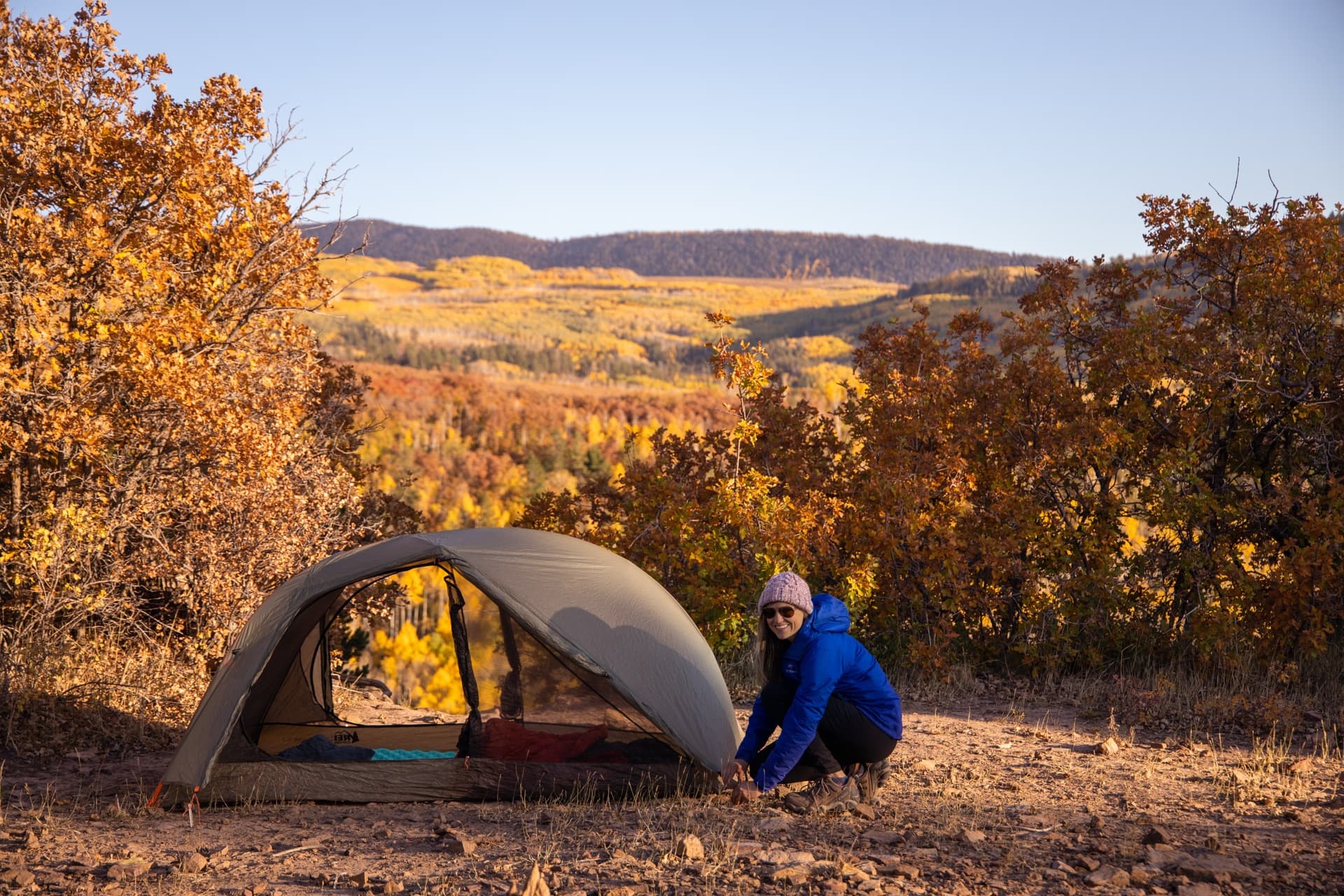
Fall is my favorite time of year for getting outside. The temperatures are comfortable, the landscapes are bursting with color, and everything is less crowded. Camping in the fall also means that you can score awesome campsites that would be impossible to get in the busy summer season.
When I’m planning a fall camping trip, I always take a few extra steps to prepare for camping in cooler, unpredictable weather, shorter days, and pending road closures that can make some campsites inaccessible.
Read on for my best fall camping tips to help you pack and plan, so you can enjoy being outside without freezing your butt off.
Ways to Save on Fall Gear
Before I share my tips, I wanted to let you know about some of the cool deals happening during REI Co-op’s Member Days, which runs from 9/12 – 9/22. Taking advantage of these promotions can help you save on fall camping clothing and gear and increase the rewards you get back next spring!
- REI Co-op Members get $20 off when you spend $100 or more online at REI Outlet from 9/18/25 thru 9/22/25. Use coupon code OUTFALL25 at checkout.
- REI Co-op cardmembers earn 2X (10%) on all REI purchases (in addition to normal member rewards)
- Members get an extra 20% off a Bike Tune Package
- Members get an extra 20% off Re/Supply products (in-store only)
Join the Co-op today!
If you join the REI Co-op ($30 for a lifetime Membership) before 11/24 and spend $50 in store, you will get a $30 bonus card to apply to a future purchase – which means the membership pays for itself!

As a Member, you’ll get 10% back on all eligible purchases each Spring, a generous 1-year return policy, and a ton of other awesome perks that are the best in the industry!
Disclosure: REI has been a partner of mine for years, and they’re always my first stop for outdoor gear. I’m proud to support a Member-owned co-op that’s given over $3 million since 2021 to organizations helping people and communities connect with the outdoors.
This post may contain affiliate links.
Save this post!
Enter your email & I'll send this post to your inbox! You'll also receive my weekly newsletter full of helpful advice for planning your adventures.
1. Check the weather
I always check the weather before I leave for a fall camping trip. Knowing the chance of rain and the nighttime lows helps me pack accordingly. I personally find the forecasts at weather.gov to be the most accurate.
Once I’m at camp, if I don’t have cell service, I use my Garmin Mini to pull up the forecast every morning so I can see if there’s any incoming weather to be aware of.
2. Arrive at camp early
The sun sets much earlier in the fall, so in order to make the most of my first evening at camp, I always try to arrive early enough to set up camp and make dinner before the sun goes down.
That way by the time it gets cold, I’m done with the hard work so I can get cozy in my warm clothes around the campfire.
3. Pack a propane fire pit
A campfire is an essential part of making fall camping enjoyable. These days due to increasing wildfire risk, I prefer a portable propane fire pit one over a wood fire. They crank plenty of heat, there’s no smoke blowing in your face, and you don’t have to worry that the last person up will douse it with water when it’s time for bed. You just have to make sure you bring a full propane tank that will last through the evenings.
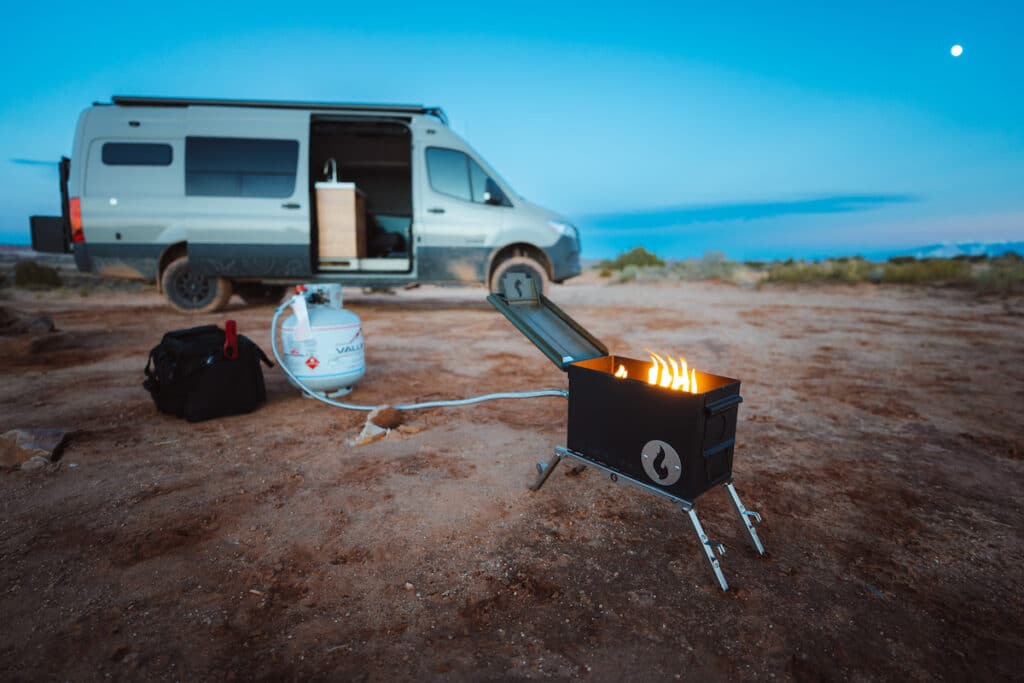
4. Bring some string lights
With the sun setting so early, you can create a nice ambiance at camp by hanging some string lights around camp. This way you don’t have to have your headlamp on the entire evening.
These Biolite Luci String Lights can be charged by USB or solar, don’t tangle too easily, and can last up to 40 hours on a single charge. I have two sets of these, and they come with me on every trip, fall or otherwise.
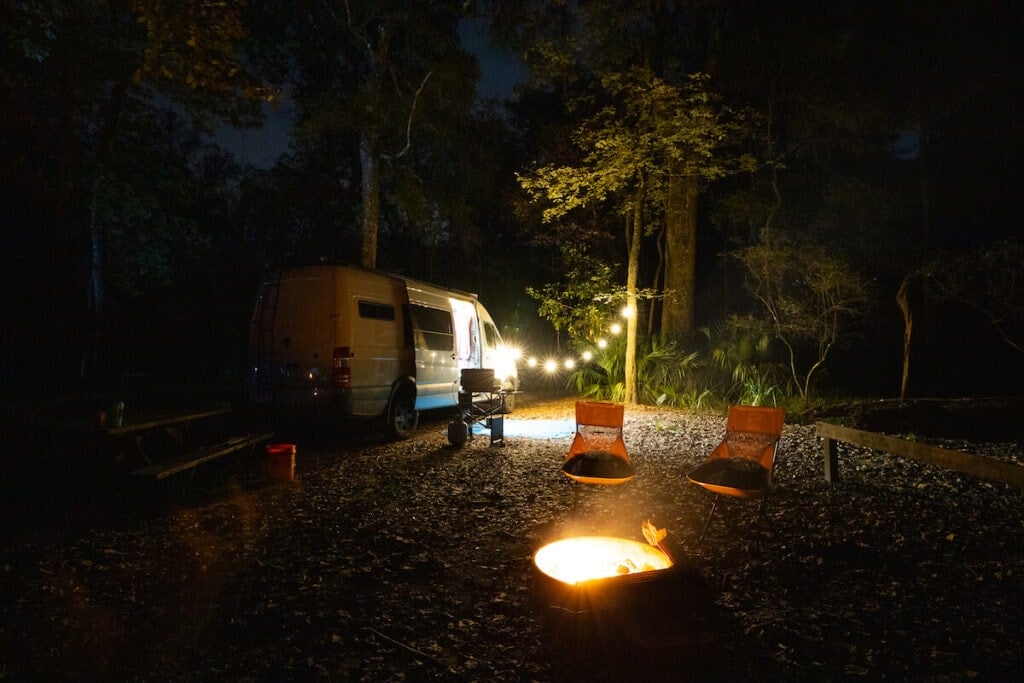
5. Pack your tent’s rain fly
Even if rain isn’t predicted, be sure to bring your tent’s rainfly and an extra tarp or footprint that fits under your tent. The weather can change rapidly in the fall and you just never know!
In addition to weather protection, the rainfly also adds warmth by reducing the cross breeze in your tent at night and trapping in some heat.
6. Bring a tarp or pop-up shelter
If the weather forecast calls for rain, bring a tarp or a pop up shelter. You’ll be thankful you have somewhere dry to relax and cook dinner other than being cooped up in your tent.
Tarps like the Kammok Kuhli Shelter are great because they don’t take up a ton of room in your car and will keep you dry at camp if it starts to rain. They can be a bit difficult to set up though, so you’ll want to practice at home first.
If space isn’t a concern, then Costco or Amazon sells pop up shelters that are very quick and easy to set up. Just make sure you stake it down properly so it doesn’t blow away in the wind.

7. Bring layers to wear
In fall, you can get huge swings in temperatures. It might be in the upper 60s during the day and down in the 30s at night.
The key is to layer, layer, layer. Assuming you are car camping and you can easily throw in a few additional items, it’s always better to pack a little extra warmth just in case.
The clothes I bring camping are very similar to what I wear hiking in the fall. I recommend synthetic materials for your outerwear and either synthetic or wool for base layers. Avoid cotton as it doesn’t retain heat if it gets wet and takes a long time to dry.
Here are some of the specific layers I bring fall camping:
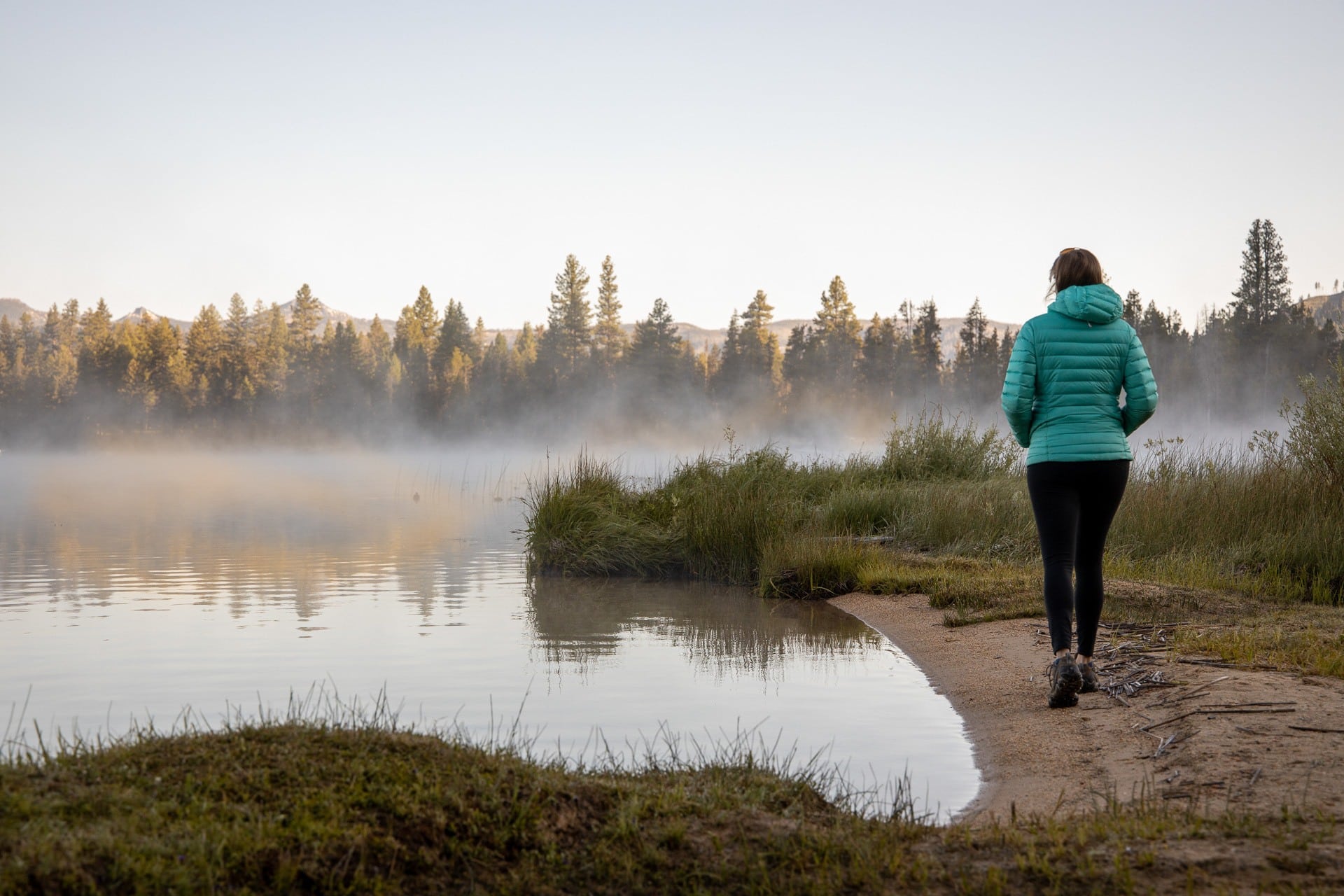
8. Have an extra pair of clothes dedicated for sleep
If it ends up raining and you get wet, you don’t want to go to bed in damp clothing. I always pack an extra pair of dry clothes and socks that I can wear in my sleeping bag.
9. Bring camp slippers
Pro fall camping tip right here. Insulated camp slippers are a game changer for fall camping. They help keep my feet warmer and more comfortable than wearing my hiking boots around camp all night.
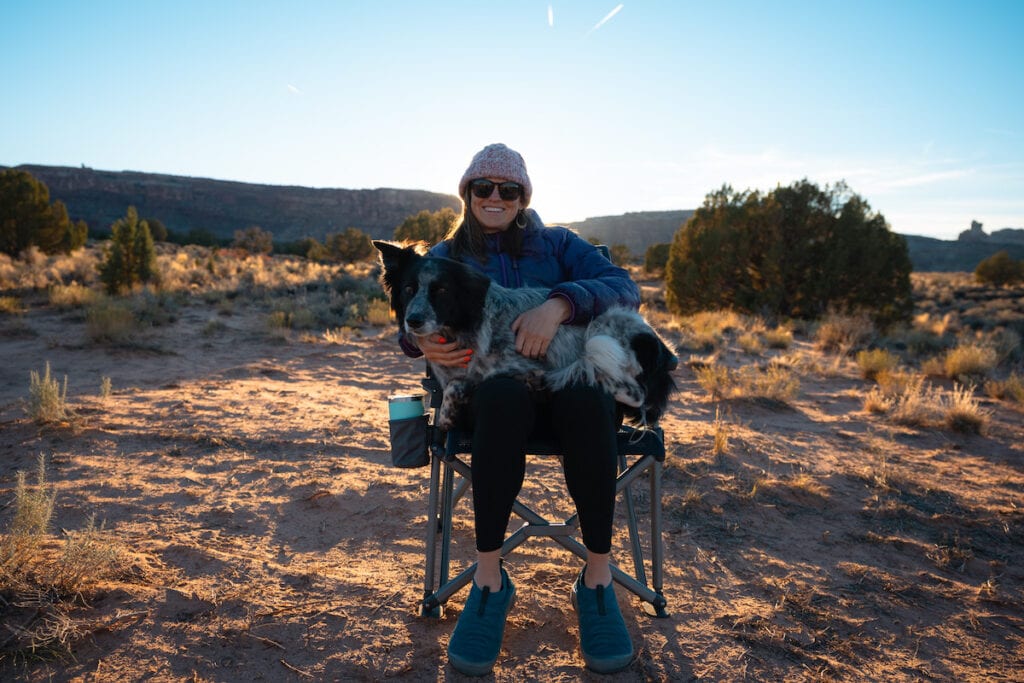
10. Pack waterproof hiking boots
In summer, waterproof hiking shoes or boots can get a little stuffy, but in fall, you’ll be glad you have waterproof shoes. Not only are they warmer, providing more insulation in chilly temperatures, if it does rain, you won’t end up with soggy, cold feet. Hiking boots also provide more traction relative to an old pair of tennis shoes if the ground is slippery at camp.
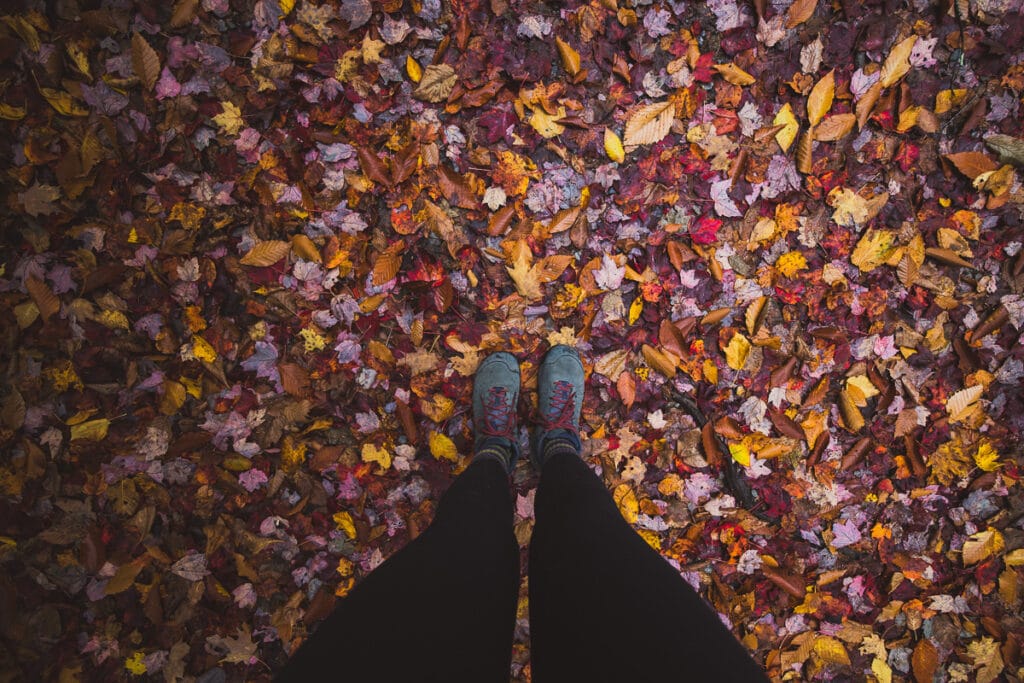
Read More
Fall Camping Apparel
11. Check your sleeping bag’s temperature rating
Every sleeping bag has a temperature rating and it’s important you understand what that rating means.
For example, a 30-degree bag means that if it gets down to 30 degrees, you won’t freeze to death. But it does NOT mean you’ll be nice and toasty if it’s 30 degrees out. A 30-degree bag at 30 degrees is going to make for a very long and chilly night.
I personally get cold very easily, so if I am going to camp in 30-degree weather, I would want a 0 or 10-degree bag.
Before you leave on your autumn camping trip, make sure to check your sleeping bag’s temperature rating (you can usually find it somewhere printed on your bag), and make sure it’s appropriate for what the forecast is calling for.
If you need a new sleeping bag, check out my list of the Best Sleeping Bags for Backpacking. Another cheap solution is to simply bring extra blankets from home (in addition to your sleeping bag), rent a sleeping bag, or add a sleeping bag liner to your sleeping bag.
12. Consider a Double Sleeping Bag or Quilt
If you are camping with a significant other, consider using a double sleeping bag or quilt. The body heat will help you stay much warmer at night compared to sleeping in a single sleeping bag.
Ryan and I use the Enlightened Equipment 2-person Accomplice Quilt. It attaches to your sleeping pad with a pair of straps and clips and each person can open or close their side to regulate their own temperature.
For more recommendations, check out my roundup on the best 2-person sleeping bags.

13. Pack an Insulated Sleeping Pad
Another term you’ll want to know is the insulation value of your sleeping pad. Most sleeping pads measure this via an R-value, and a higher number (3.5+) will provide more insulation from the cold ground.
My go-to sleeping pad for fall camping is the NEMO Roamer Sleeping Pad that has an R-value of 6. It’s extra thick, extra warm, and extra comfy. You can read my 2-person NEMO Roamer review for more info on this pad.
If your sleeping pad has a lower R-value and you don’t want to invest in a new expensive pad, throwing an inexpensive foam sleeping pad underneath your inflatable sleeping pad should do the trick.
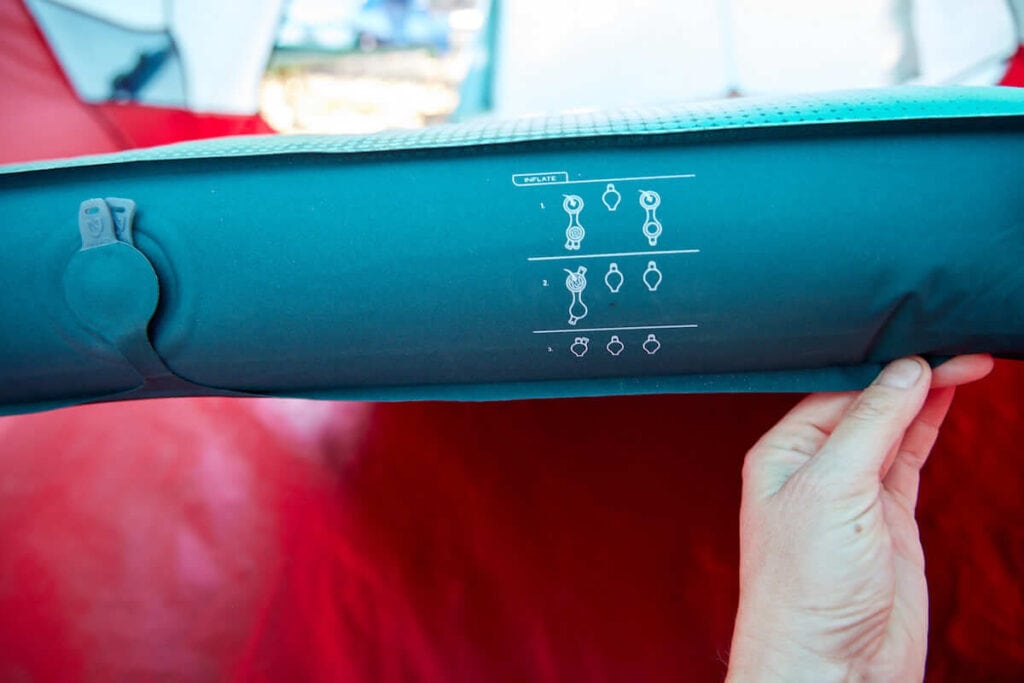
14. Bring a Hot Water Bottle in your Sleeping Bag
A final sleeping hack that is super effective for staying warm is to fill a Nalgene bottle or hot water bottle with hot water.
Bring that with you to bed and store it inside your sleeping bag (wrapped in a shirt so it’s not too hot against your skin). Voila, you’ve got a hot water bottle portable heater.
15. Have a Spacious, Reliable Tent
Fall is not the time to test out the tent that you got at your local garage sale. If it rains or is really windy and your tent fails, you will end sleeping half reclined in your car.
For fall car camping when the weather could be iffy, I use the REI Base Camp 4. It’s a 4-person tent with two huge vestibules so you can spread out. I’ve used this in multiple rain storms now, and I’ve been impressed with how well it’s withstood wind and rain. For more details on this tent, see my REI Base Camp 4 Tent Review.
I also recommend sizing up. Pack a 3-person tent for 2-people or a 4-person tent for 3-people. That way if you end up having to hide out for a bit, you won’t be too cramped.
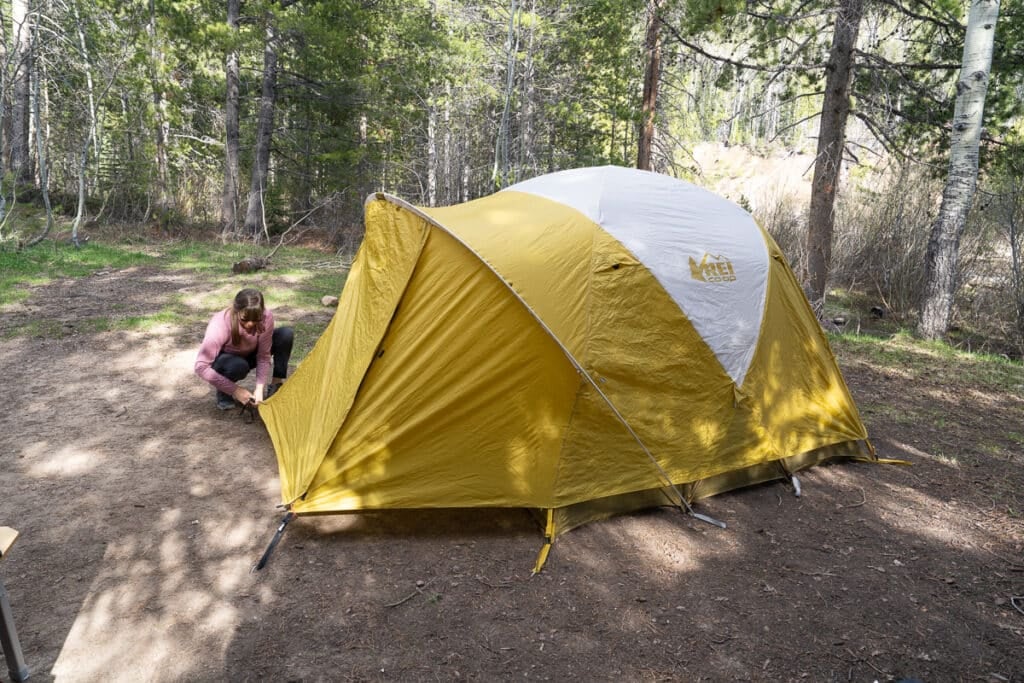
16. Check the fall foliage map
For the best leap peeping on your fall camping trip, check the fall foliage map on the American Forests website. You can move the slider to the weekend you want to camp and see where you can experience the peak fall colors.
I also have a few fall itineraries that are worth checking out:
- Fall Colorado Road Trip Itinerary
- Best Places to Leaf Peep in Vermont
- Smoky Mountains Fall Travel Guide
- Best National Parks to Visit in Fall
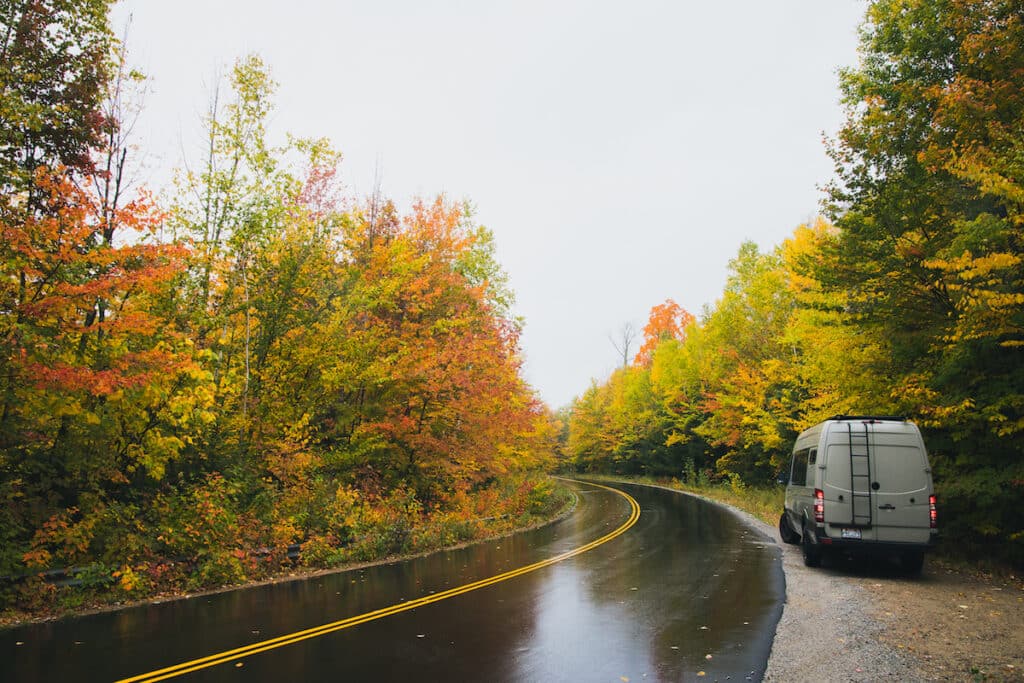
17. Make sure the campsite is accessible
Then, if you are planning to stay in an established campground, make sure the campground is still open and make a reservation if you can. Many campgrounds close up shop in late September or early October for winter.
The same goes for Forest Service roads where you might be looking for dispersed camping. You don’t want to drive off the grid and out of cell phone service just to find out that where you were planning to camp is no longer an option.
When picking a campsite, you should start by downloading one of my favorite campsite finder apps. That way you’ll know what your options are in the area you plan to camp.
iOverlander and onX Offroad are favorite apps for finding free dispersed camping..
The Dyrt and recreation.gov are useful for fiding paid campgrounds.
18. Check road conditions
Even if the camping area is open, that doesn’t mean it’s going to be accessible. It’s really dependent on road conditions and your vehicle. If you plan to dispersed camp along a dirt road, make sure your vehicle is equipped to handle any conditions you might encounter, like mud from recent rain storms or any rain to come.
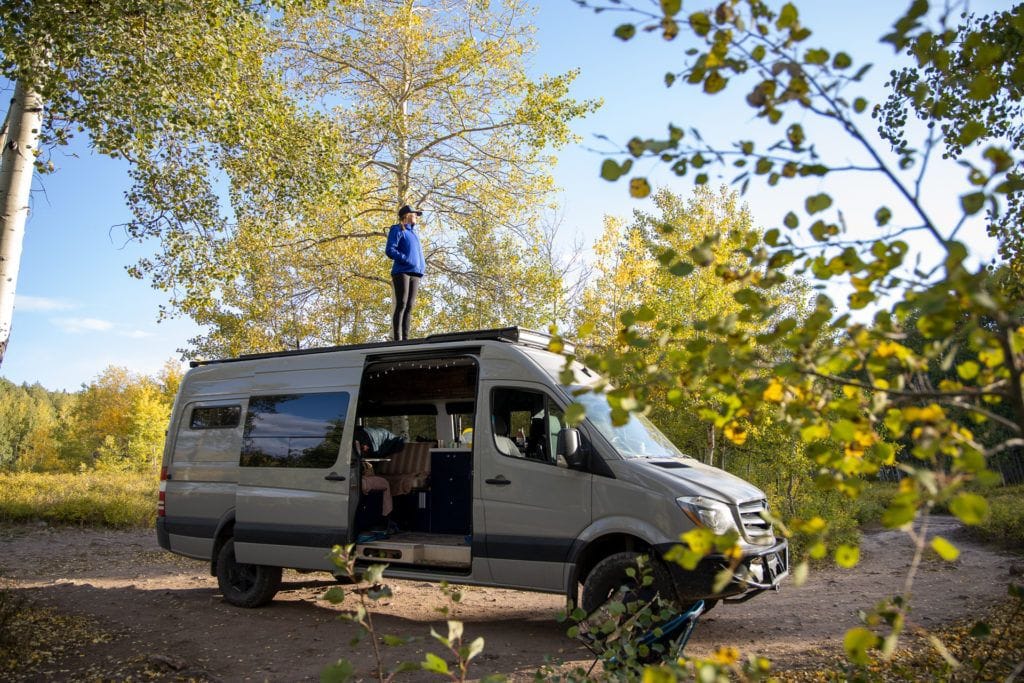
19. Plan a fun day hike
Pick a hiking trail that shows off the fall colors. Just remember that the days are much shorter in the fall. Fall is a good time to brush up on your hiking safety knowledge.
Here are some quick tips for hiking in the fall:
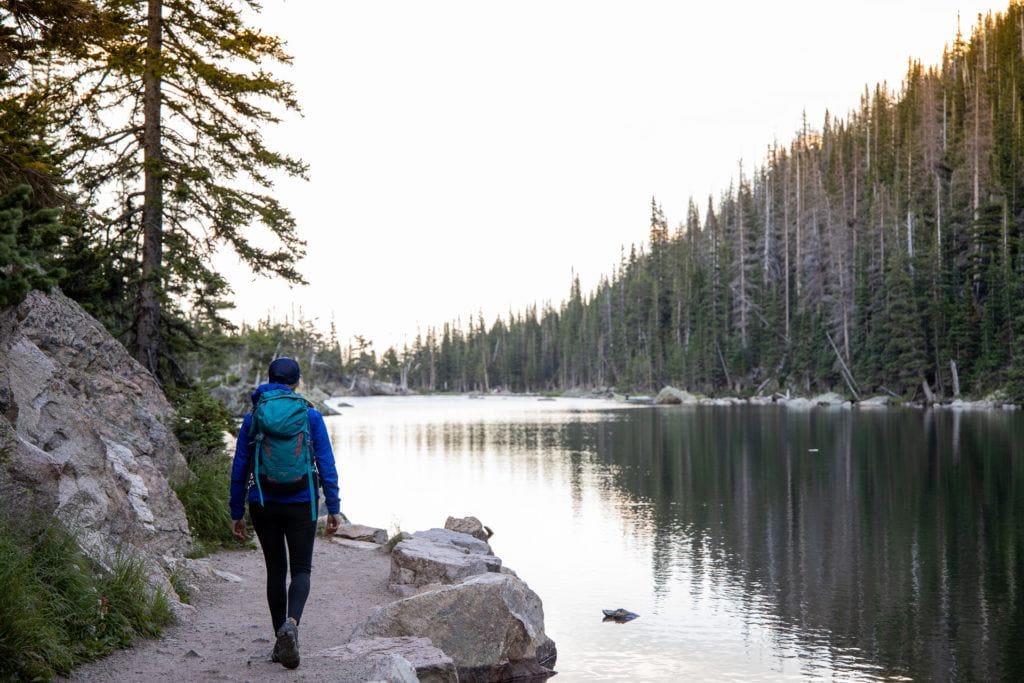
20. Practice your photography
Fall is an easy and fun time to shoot photos on your fall camping trip, and even beginner photographers can get some glorious results. It’s one of the reasons I love fall camping!
If you’re curious about night photography, it’s also a great time because the stars come out much earlier in fall than they do in summer.
21. Bring Camp Games
Glow in the dark bocce is my favorite nighttime camping game, and it’s especially good since it gets dark early in the fall. Tabletop ping pong is another.
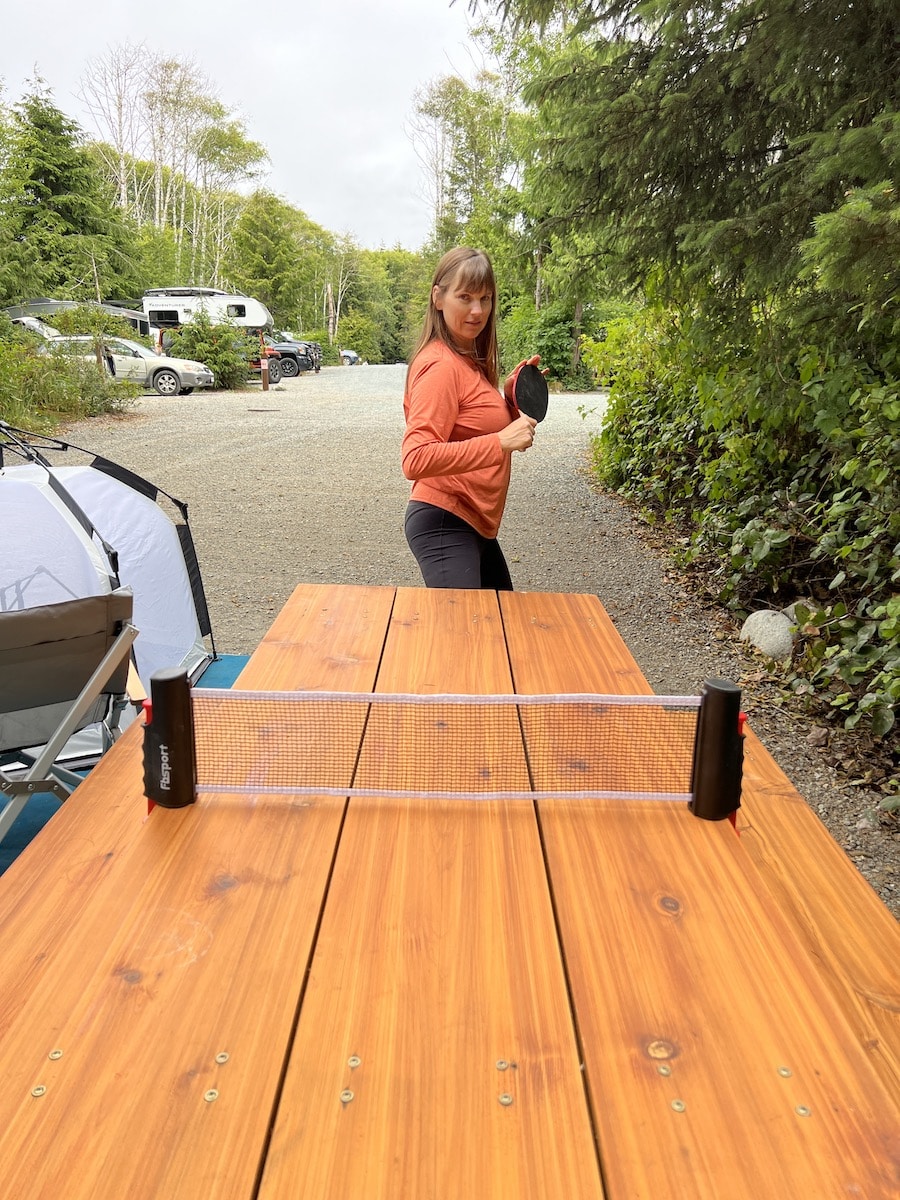
22. Prep your meals at home
I recommend doing some of your meal prep at home to speed up the dinner-making process. Then pack whatever camp cooking essentials you need to finish the job.
That might mean chopping vegetables at home or pre-making a pot of chili and simply reheating at camp. The quicker you can make dinner, the sooner you get to relax and get warm around the fire with a hot beverage.
23. Plan hot, calorie dense meals
Salads are for summer. In fall, I like cooking hot meals that will warm my belly. Soups, chili, and hearty stews are a great option that don’t require getting too many dishes dirty. Here are a few easy one pot camping meals to get you started.
24. Bring dessert!
Whether it’s s’mores or homemade brownies, a tasty treat is always fun to have while sitting around the campfire.
25. Pack hot beverages
When I was on the John Muir Trail in mid-September, one of my biggest lessons was to pack hot drinks for every night. Whether it’s hot tea with lemon and honey or a hot toddy, having a hot drink will make hanging out under the stars more enjoyable.
In order to keep your hot drinks hot longer, make them in an insulated mug – my go-to is the Yeti Rambler Tumbler.
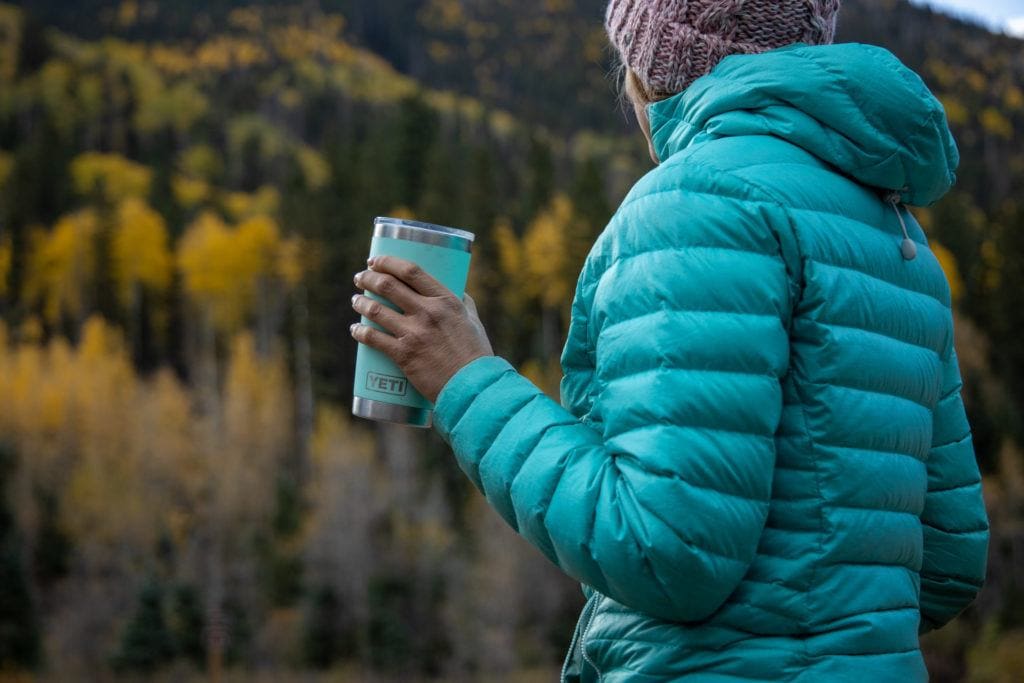
More Fall Camping Tips
Planning a fall camping trip? Share your plans, tips, and questions in the comments below!

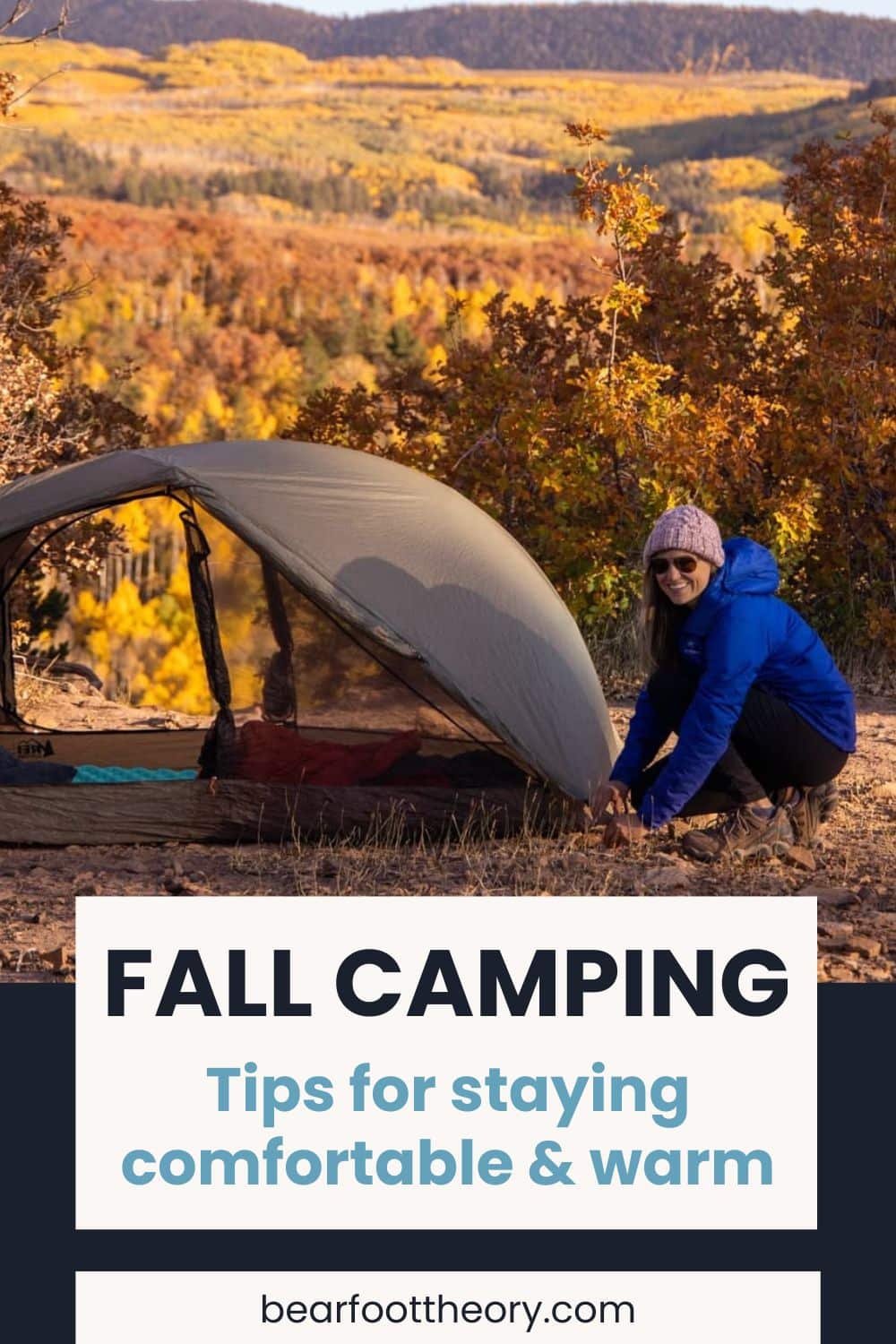
Great useful tips!
Thank you.
Hi Kristen, your blog is really inspiring. Thanks for explaining in such great detail. I have always been terrified of the camping process but hopefully one day I’ll get around to doing it on my own.
Hi Sophie!
Thanks for your comment. We hear that frequently, and that’s one thing that inspired Kristen to start this blog! We have a plethora of resources for people just like you that don’t know where to start. You can start small and simple, and then maybe work up to something bigger. Check out this blog post – even if you don’t have a partner or they’re not into it, the tips in this blog post are helpful for anyone. https://bearfoottheory.com/introduce-partner-camping/ Let us know how we can help you feel less afraid! – Mary Kathryn
A perfect camping todo’s thanks for sharing 🙂
I like your point about the days being shorter – it’s a hell of a realization when you forgot your headlamp at camp!
I do strongly prefer camping in the fall though compared to any other time of year though, the weather just can’t be beat.
You’re totally spot on about the sleeping bag rating. Many years in the scouts taught me that lesson. The night is very long when you are cold. I finally purchased a bag with a -15 degree rating. Overkill? Maybe. But I sure did sleep better and actually enjoyed cold weather camping because of it.
I’m grateful to stop and read this blog, Kristen! Your tips are very reasonable and it will help our camping plans this fall. Need to order items that I learned from your article. Thanks!
Glad you found it helpful!
These are some awesome tips! I Loved reading this article. Everything looks well thought out and written. I especially liked the section about the hot water bottle trick. That is a smart way of staying warm and comfortable in your sleeping bag. Keep up the awesome work!
Thanks Caleb! Glad you found it helpful.
Thanks for the tips. We already have most of these items and are preparing for our first run at camping. Technically it’s a practice prior to Big Bend! It may be fall, but it’s still hot af here in Texas. Our state parks are year rounders! I expect it will get very hot in the tent and will probably wish it were much cooler outside.
P.S. How does one get an REI sponsored post?
Hi David, thanks for reading! So nice you can enjoy your state parks year-round. A tent with a mesh upper can help with airflow in warm temps, and you can even sleep with the fly (the cover) off or rolled back for more ventilation. We love REI and have been working with them for years – we shop there for most of our hiking, camping, and other outdoor adventure needs and are always recommending products that they sell so it’s a natural fit 🙂